

ПАЛІПЕРИДОН СТАДА 150 мг СУСПЕНЗІЯ ДЛЯ ІН'ЄКЦІЙ ПРОЛОНГОВАНОЇ ДІЇ У ПЕРЕДНАПОЛНЕНИХ ШПРИЦАХ


Інструкція із застосування ПАЛІПЕРИДОН СТАДА 150 мг СУСПЕНЗІЯ ДЛЯ ІН'ЄКЦІЙ ПРОЛОНГОВАНОЇ ДІЇ У ПЕРЕДНАПОЛНЕНИХ ШПРИЦАХ
Введення
Опис: інформація для користувача
Паліперидон Стада 50 мг суспензія для ін'єкцій із тривалою дією
у попередньо наповненому шприціЕФГ
Паліперидон Стада 75 мг суспензія для ін'єкцій із тривалою дією
у попередньо наповненому шприціЕФГ
Паліперидон Стада 100 мг суспензія для ін'єкцій із тривалою дією
у попередньо наповненому шприціЕФГ
Паліперидон Стада 150 мг суспензія для ін'єкцій із тривалою дією
у попередньо наповненому шприціЕФГ
Прочитайте уважно весь опис перед тим, як почати використовувати цей лікарський засіб, оскільки він містить важливу інформацію для вас.
- Збережіть цей опис, оскільки вам може знадобитися знову його прочитати.
- Якщо у вас виникли питання, проконсультуйтеся з вашим лікарем, фармацевтом або медсестрою.
- Цей лікарський засіб призначений лише для вас, і не слід давати його іншим людям, навіть якщо вони мають相同ні симптоми, оскільки це може нашкодити їм.
- Якщо ви відчуваєте побічні ефекти, проконсультуйтеся з вашим лікарем, фармацевтом або медсестрою, навіть якщо це побічні ефекти, які не вказані в цьому описі. Див. розділ 4.
Зміст опису
- Що таке Паліперидон Стада і для чого він використовується
- Що вам потрібно знати перед тим, як почати використовувати Паліперидон Стада
- Як використовувати Паліперидон Стада
- Можливі побічні ефекти
- Збереження Паліперидон Стада
- Зміст упаковки та додаткова інформація
1. Що таке Паліперидон Стада і для чого він використовується
Паліперидон Стада містить активну речовину паліперидон, яка належить до класу антипсихотичних лікарських засобів, і використовується як підтримуюче лікування симптомів шизофренії у дорослих пацієнтів, які стабілізувалися під впливом паліперидону або рисперидону.
Якщо ви раніше реагували на паліперидон або рисперидон і маєте легкі або помірні симптоми, ваш лікар може призначити лікування паліперидоном без попередньої стабілізації під впливом паліперидону або рисперидону.
Шизофренія - це розлад з "позитивними" і "негативними" симптомами. "Позитивний" означає надмірність симптомів, які зазвичай не присутні. Наприклад, людина з шизофренією може чути голоси або бачити речі, які не існують (галюцинації), мати неправильні переконання (делюзії) або мати надмірну підозрілість до інших. "Негативний" відноситься до відсутності поведінки або почуттів, які зазвичай присутні. Наприклад, людина з шизофренією може ізолюватися від інших і не реагувати на жодні емоційні стимули або можуть мати проблеми з чіткою і логічною мовою. Люди, які страждають на цей розлад, також можуть відчувати депресію, тривогу, провину або напругу.
Паліперидон може допомогти полегшити симптоми вашого захворювання і запобігти їх повторенню.
2. Що вам потрібно знати перед тим, як почати використовувати Паліперидон Стада
Не використовуйте Паліперидон Стада
- якщо ви алергічні на паліперидон або на будь-який інший компонент цього лікарського засобу (перелічені в розділі 6)
- якщо ви алергічні на будь-який інший антипсихотичний лікарський засіб, включаючи рисперидон.
Попередження та обережність
Проконсультуйтеся з вашим лікарем, фармацевтом або медсестрою перед тим, як почати використовувати паліперидон.
Цей лікарський засіб не був вивчений у пацієнтів похилого віку з деменцією. Однак пацієнти похилого віку з деменцією, які лікуються іншими подібними лікарськими засобами, можуть мати підвищений ризик інсульту або смерті (див. розділ 4, Можливі побічні ефекти).
Всі лікарські засоби мають побічні ефекти, і деякі з них можуть погіршити симптоми інших захворювань. Тому важливо обговорити з вашим лікарем будь-які з наступних захворювань, які можуть погіршити під час лікування цим лікарським засобом:
- якщо ви маєте захворювання Паркінсона
- якщо ви коли-небудь були діагностовані з захворюванням, симптомами якого є підвищена температура і м'язова ригідність (також відоме як синдром нейролептичної мальігнації)
- якщо ви коли-небудь мали аномальні рухи мови або обличчя (тардива дискінезія)
- якщо ви мали низький рівень лейкоцитів у крові (що може бути викликано іншими лікарськими засобами)
- якщо ви є діабетиком або маєте схильність до діабету
- якщо ви мали рак молочної залози або пухлину гіпофізу
- якщо ви маєте захворювання серця або приймаєте лікування серцевих захворювань, яке може зробити вас більш схильним до зниження артеріального тиску
- якщо ви маєте низький артеріальний тиск, коли встаєте або встаєте раптово
- якщо ви маєте епілепсію
- якщо ви маєте проблеми з нирками
- якщо ви маєте проблеми з печінкою
- якщо ви маєте тривалу або болючу ерекцію
- якщо ви маєте проблеми з регулюванням температури тіла або відчуваєте жар
- якщо ви маєте аномально високий рівень пролактину в крові або маєте пухлину, яка залежить від пролактину
- якщо ви або хтось з вашої родини має історію тромбозу, оскільки антипсихотичні лікарські засоби можуть бути пов'язані з утворенням тромбів.
Якщо ви маєте будь-яке з цих захворювань, будь ласка, проконсультуйтеся з вашим лікарем, оскільки може знадобитися корекція вашої дози або спостереження за вами протягом певного часу.
- Через те, що дуже рідко спостерігалося у пацієнтів, які приймають цей лікарський засіб, небезпечно низький рівень певного типу лейкоцитів, необхідних для боротьби з інфекціями в крові, ваш лікар може перевірити рівень лейкоцитів у вашій крові.
- Навіть якщо ви раніше переносили пероральний паліперидон або рисперидон, рідко трапляються алергічні реакції після ін'єкцій паліперидону. Проконсультуйтеся з вашим лікарем негайно, якщо ви відчуваєте висип, набряк горла, свербіж або проблеми з диханням, оскільки ці можуть бути ознаками важкої алергічної реакції.
- Цей лікарський засіб може викликати збільшення ваги. Значне збільшення ваги може негативно вплинути на ваше здоров'я. Ваш лікар буде регулярно контролювати вашу вагу.
- У пацієнтів, які приймають цей лікарський засіб, спостерігалося цукровий діабет або погіршення діабету, тому ваш лікар повинен перевірити ознаки підвищення рівня цукру в крові. У пацієнтів з діабетом необхідно регулярно контролювати рівень цукру в крові.
- Через те, що цей лікарський засіб може знижувати блювотний рефлекс, існує можливість того, що він може маскувати нормальну реакцію організму на прийняття токсичних речовин або інших захворювань.
- Під час операції на оці з катарактою пупила (коло чорне в центрі ока) може не збільшуватися в розмірах так, як потрібно. Крім того, райдужна оболонка (колірна частина ока) може ставати флячкою під час операції, що може викликати пошкодження ока. Якщо ви плануєте операцію на оці, повідомте вашого офтальмолога про те, що ви приймаєте цей лікарський засіб.
Діти та підлітки
Не використовуйте цей лікарський засіб у дітей молодше 18 років.
Інші лікарські засоби та Паліперидон Стада
Повідомте вашому лікареві про будь-які інші лікарські засоби, які ви приймаєте, приймали нещодавно або можете приймати.
- Прийом цього лікарського засобу разом з карбамазепіном(антієпілептичним та стабілізуючим настрій лікарським засобом) може потребувати зміни вашої дози цього лікарського засобу.
- Через те, що цей лікарський засіб діє в основному на мозок, взаємодія з іншими лікарськими засобами, які також діють на мозок, може викликати посилення побічних ефектів, таких як сонливість або інші ефекти на мозок, наприклад, інші психіатричні лікарські засоби, опіоїди, антигістамінита лікарські засоби для сну.
- Через те, що цей лікарський засіб може знижувати артеріальний тиск, вам потрібно бути обережним, якщо ви приймаєте цей лікарський засіб з іншими лікарськими засобами, які знижують артеріальний тиск.
- Цей лікарський засіб може знижувати ефект лікарських засобів для захворювання Паркінсона та синдрому неспокійних ніг(наприклад, леводопа).
- Цей лікарський засіб може викликати аномалію на електрокардіограмі (ЕКГ), яка вказує на те, що необхідно тривале время для проходження електричного імпульсу через певну частину серця (відоме як "продовження інтервалу QT"). Інші лікарські засоби, які мають цей ефект, включають деякі лікарські засоби для лікування серцевого ритму або інфекційта інші антипсихотичні лікарські засоби.
- Якщо ви схильні до розвитку судових нападів, цей лікарський засіб може збільшити ваші шанси на їх розвиток. Інші лікарські засоби, які мають цей ефект, включають деякі лікарські засоби для лікування депресії або інфекційта інші антипсихотичні лікарські засоби.
- Паліперидон повинен використовуватися з обережністю з лікарськими засобами, які збільшують активність центральної нервової системи (психостимулятори, такі як метилфенідат).
Використання Паліперидон Стада з алкоголем
Алкоголь слід уникати.
Вагітність та лактація
Якщо ви вагітні або годуєте грудьми, вважаєте, що можете бути вагітною або плануєте вагітність, проконсультуйтеся з вашим лікарем або фармацевтом перед тим, як використовувати цей лікарський засіб.
Вагітність
Не використовуйте цей лікарський засіб під час вагітності, якщо тільки ваш лікар не порадив вам цього. Можуть виникнути наступні симптоми у новонароджених дітей матерів, які приймали паліперидон у останньому триместрі вагітності (останні три місяці вагітності): тремор, м'язова ригідність та/або слабкість, сонливість, агітація, проблеми з диханням та труднощі з харчуванням. Якщо ваша дитина розвиває будь-який з цих симптомів, негайно проконсультуйтеся з вашим лікарем.
Грудне вигодовування
Цей лікарський засіб може передаватися від матері до дитини через грудне молоко та може нашкодити дитині. Тому не слід годувати грудьми під час прийому цього лікарського засобу.
Водіння транспортних засобів та використання машин
Під час лікування цим лікарським засобом можуть виникнути головокружіння, надмірна втома та проблеми з зором (див. розділ 4). Це слід враховувати при необхідності максимальної уваги, наприклад, при водінні транспортних засобів або використанні машин.
Паліперидон Стада містить натрій
Цей лікарський засіб містить менше 1 ммоль натрію (23 мг) на дозу; тобто, він практично "не містить натрію".
3. Як використовувати Паліперидон Стада
Ваш лікар або інший медичний працівник введе цей лікарський засіб. Ваш лікар призначить час наступної ін'єкції. Важливо не пропускати жодної з запланованих ін'єкцій. Якщо ви не можете відвідати прийом у лікаря, негайно зв'яжіться з ним, щоб призначити інший термін якомога скоріше.
Доза та спосіб введення
Ви отримаєте першу ін'єкцію (150 мг) та другу ін'єкцію (100 мг) цього лікарського засобу в верхню частину руки приблизно з інтервалом у тиждень. Після цього ви отримуватимете ін'єкцію (від 25 мг до 150 мг) в верхню частину руки або в сідниці один раз на місяць.
Якщо ваш лікар змінює вас з рисперидону довгої дії на цей лікарський засіб, ви отримаєте першу ін'єкцію цього лікарського засобу (від 25 мг до 150 мг) в верхню частину руки або в сідниці під час наступної запланованої ін'єкції. Після цього ви отримуватимете ін'єкцію (від 25 мг до 150 мг) в верхню частину руки або в сідниці один раз на місяць.
Відповідно до ваших симптомів лікар може збільшити або зменшити кількість лікарського засобу, який ви отримуєте, на рівні дози під час місячного введення.
Пацієнти з проблемами нирок
Ваш лікар може коригувати дозу цього лікарського засобу відповідно до вашої ниркової функції. Якщо у вас легкі проблеми з нирками, ваш лікар може призначити меншу дозу. Не слід використовувати цей лікарський засіб, якщо у вас помірні або важкі проблеми з нирками.
Пацієнти похилого віку
Ваш лікар може зменшити дозу цього лікарського засобу, якщо ваша ниркова функція знижена.
Якщо ви отримали більше Паліперидон Стада, ніж потрібно
Ви отримуватимете цей лікарський засіб під медичним наглядом; тому малоймовірно, що ви отримаєте надмірну дозу.
Пацієнти, які отримали надмірну дозу паліперидону, можуть відчувати наступні симптоми: сонливість або седація, швидка серцева діяльність, низький артеріальний тиск, аномалії на електрокардіограмі (запис електричної діяльності серця) або повільні або аномальні рухи обличчя, тіла, рук або ніг.
У разі передозування або випадкового прийому лікарського засобу зверніться до вашого лікаря або зателефонуйте до служби токсикологічної інформації, телефон: 91 562 04 20, вказавши лікарський засіб та кількість, прийняту.
Якщо ви припините лікування Паліперидон Стада
Якщо ви припините отримувати ін'єкції, ви втратите ефект лікарського засобу. Не слід припиняти використання цього лікарського засобу, якщо тільки ваш лікар не порадив вам цього, оскільки можуть знову виникнути симптоми.
Якщо у вас є будь-які інші питання щодо використання цього лікарського засобу, проконсультуйтеся з вашим лікарем або фармацевтом.
4. Можливі побічні ефекти
Як і всі лікарські засоби, цей лікарський засіб може викликати побічні ефекти, хоча не всі люди їх відчувають.
Негайно повідомте своєму лікареві, якщо:
- ви маєте кров'яні згустки у венах, особливо у ногах (симптоми включають набряк, біль і почервоніння ноги), які можуть рухатися через кровоносні судини до легень, викликаючи біль у грудній клітці та труднощі з диханням. Якщо ви помітили будь-які з цих симптомів, негайно зверніться за медичною допомогою.
- у вас є деменція та раптовий зміна вашого психічного стану або раптова слабкість чи оніміння обличчя, рук або ніг, особливо на одному боці, або у вас виникають труднощі з мовленням, навіть протягом короткого періоду часу. Це можуть бути ознаки інсульту.
- ви маєте гарячку, м'язову ригідність, потіння або зниження рівня свідомості (розлад, відомий як "Синдром нейролептичної малінгності"). Ви можете потребувати негайної медичної допомоги.
- ви чоловік і маєте тривалу чи болючу ерекцію. Це називається пріапізмом. Ви можете потребувати негайної медичної допомоги.
- ви маєте ритмічні рухи мови, рота чи обличчя. Це може бути ознакою необхідності виведення паліперидони.
- ви маєте серйозну алергічну реакцію, характеризовану гарячкою, набряком рота, обличчя, губ чи язика, труднощами з диханням, свербінням, висипом на шкірі та іноді зниженням артеріального тиску (анafilактична реакція). Навіть якщо раніше ви переносили пероральну рісперидону чи паліперидону, іноді з'являються алергічні реакції після отримання ін'єкцій паліперидони.
- ви плануєте операцію на оці, повідомте своєму офтальмологу, що приймаєте цей лікарський засіб. Під час операції на оці з опaciфікацією кришталика (катаракти) можливо, що райдужна оболонка (колірна частина ока) стане м'якою під час операції (що називається "Синдромом м'якої райдужної оболонки"), що може викликати пошкодження ока.
- ви маєте небезпечно низький рівень певного типу білих кров'яних клітин, необхідних для боротьби з інфекціями крові.
Можуть виникнути наступні побічні ефекти:
Дуже часті:можуть впливати на більше 1 з 10 осіб
- труднощі з сном.
Часті:можуть впливати на до 1 з 10 осіб
- симптоми простудного захворювання, інфекції сечовивідних шляхів, відчуття, ніби у вас є грип
- Паліперидона може збільшувати рівні певної гормони, званої "пролактином", яка виявляється в аналізах крові (що може чи не може викликати симптоми). Коли з'являються симптоми підвищення пролактину, вони можуть включати (у чоловіків) набряк грудей, труднощі з досягненням чи підтриманням ерекції чи інші сексуальні дисфункції; (у жінок) незручність у грудях, виділення молока з грудей, відсутність місячних чи інші проблеми з циклом
- збільшення цукру в крові, збільшення ваги, зниження ваги, зниження апетиту
- ірритація, депресія, тривога
- паркінсонізм: це захворювання може включати повільний чи змінений рух, відчуття ригідності чи напруження м'язів (що викликає раптові рухи) та іноді відчуття "замороження" руху, яке потім відновлюється. Інші ознаки паркінсонізму включають повільну ходу, трусіння під час відпочинку, збільшення слини та/або слинування і зниження виразності обличчя
- незручність, відчуття сонливості чи меншої уваги
- дистонія: це розлад, який включає повільну чи тривалу інволюційну контракцію м'язів. Хоча будь-яка частина тіла може бути уражена (і може викликати аномальні постави), дистонія часто уражає м'язи обличчя, включаючи аномальні рухи очей, рота, язика чи щелепи
- головокружіння
- дискінезія: цей розлад включає інволюційні м'язові рухи та може включати повторювані, спазматичні чи скруті рухи, або спазми
- трусіння (агитація)
- головний біль
- швидке серцебиття
- збільшення артеріального тиску
- кашель, кон'юнктивіт
- біль у животі, блювота, нудота, запор, діарея, диспепсія, біль у зубах
- збільшення трансаміназ печінки в крові
- біль у кістках чи м'язах, біль у спині, біль у суглобах
- відсутність місячних
- гарячка, слабкість, втома (знесиління)
- реакція на місці ін'єкції, включаючи свербіння, біль чи набряк
Менш часті:можуть впливати на до 1 з 100 осіб
- пневмонія, інфекція легень (бронхіт), інфекція дихальних шляхів, інфекція синусів, інфекція сечового міхура, інфекція вух, інфекція нігтів на ногах, ангіна, інфекція шкіри
- зниження кількості білих кров'яних клітин, зниження певного типу білих кров'яних клітин, які допомагають боротися з інфекціями, анемія
- алергічна реакція
- цукровий діабет чи погіршення діабету, збільшення інсуліну (гормону, який контролює рівень цукру в крові) в крові
- збільшення апетиту
- зниження апетиту, яке викликає недоїдання та зниження ваги тіла
- збільшення тригліцеридів в крові (тип жиру), збільшення холестерину в крові
- розлад сну, ейфорія (манія), зниження сексуального потягу, нервозність, кошмари
- дискінезія, яка виникає пізно (спазми чи інволюційні рухи, які не можна контролювати на обличчі, язика чи інших частинах тіла). Повідомте своєму лікареві негайно, якщо ви відчуваєте інволюційні рухи мови, рота чи обличчя. Можливо, буде необхідне виведення цього лікарського засобу.
- оглушення, незручність, яка викликає рух частин тіла, головокружіння при встоянні, порушення уваги, проблеми з мовленням, відсутність чи порушення смаку, зниження чутливості шкіри до болю чи дотику, відчуття оніміння, поколювання чи свербіння шкіри
- запаморочення зору, інфекція очей чи "розаці ока", сухість очей
- відчуття, ніби все обертається (вертіго), звук у вухах, біль у вухах
- переривання проведення між верхньою та нижньою частинами серця, аномалія в електричній діяльності серця, подовження інтервалу QT у серці, швидке серцебиття при встоянні, повільне серцебиття, аномалії в електричному графіку серця (електрокардіограма чи ЕКГ), відчуття алету чи стуку в грудній клітці (пальпітації)
- зниження артеріального тиску, низький артеріальний тиск при встоянні (тому деякі люди, які приймають цей лікарський засіб, можуть відчувати слабкість, головокружіння чи оглушення, коли встоять чи сядуть раптово)
- труднощі з диханням, біль у горлі, носові кровотечі
- незручність у животі, інфекція шлунка чи кишок, труднощі з ковтанням, сухість рота
- надмірна кількість газу чи метеоризм
- збільшення ГГТ (ферменту печінки, званого гамма-глутамілтрансферазою) в крові, збільшення ферментів печінки в крові
- кропив'янка (або "уртикарія"), свербіння, висип, випадіння волосся, екзема, сухість шкіри, червоність шкіри, акне, підшкірний абсцес
- збільшення КФК (креатинфосфокінази) в крові, ферменту, який іноді виділяється з розкладанням м'язів
- м'язові спазми, ригідність суглобів, м'язова слабкість
- незтримання сечі, часте сечовипускання, біль при сечовипусканні
- імпотенція, розлад еякуляції, відсутність місячних чи інші проблеми з циклом (у жінок), розвиток грудей у чоловіків, сексуальна дисфункція, біль у грудях, виділення молока з грудей
- набряк обличчя, рота, очей чи губ, набряк тіла, рук чи ніг
- збільшення температури тіла
- зміна ходи
- біль у грудній клітці, незручність у грудній клітці, відчуття незручності
- затвердіння шкіри
- падіння
Рідкісні:можуть впливати на до 1 з 1000 осіб
- інфекція очей
- запалення шкіри, викликане кліщами, лускастість шкіри чи волосся
- збільшення еозінофілів (типу білих кров'яних клітин) в крові
- зниження кількості тромбоцитів (клітин крові, які допомагають зупинити кровотечу)
- агитація голови
- неповна виділення гормону, який контролює кількість сечі
- цукор у сечі
- ускладнення неконтрольованого діабету, які можуть бути смертельними
- зниження рівня цукру в крові
- надмірна кількість води
- відсутність руху чи реакції, будучи при свідомості (кататонія)
- замішання
- сонячний хід
- відсутність емоцій
- нездатність досягти оргазму
- синдром нейролептичної малінгності (замішання, зниження чи втрата свідомості, висока гарячка та сильна м'язова ригідність), проблеми з кровоносними судинами мозку, які включають раптову втрату кровотоку до мозку (інсульт чи "міні-інсульт"), відсутність реакції на стимули, втрата свідомості, зниження рівня свідомості, судоми (епілептичні напади), розлад рівноваги
- анормальна координація
- глаукома (збільшення тиску ока)
- проблеми з рухом очей, гиро очей, гіперчутливість очей до світла, збільшення сльозотечі, червоність очей
- фібриляція передсердь (анормальний серцевий ритм), нерегулярне серцебиття
- кров'яні згустки в легенях, які викликають біль у грудній клітці та труднощі з диханням. Якщо ви відчуваєте будь-які з цих симптомів, негайно зверніться за медичною допомогою.
- кров'яні згустки в венах, особливо у ногах (симптоми включають набряк, біль та почервоніння ноги). Якщо ви відчуваєте будь-які з цих симптомів, негайно зверніться за медичною допомогою.
- червоність
- труднощі з диханням під час сну (апное сну)
- конгестія легень, конгестія дихальних шляхів
- крепітус легень, свистіння
- запалення підшлункової залози, набряк язика, неконтрольоване випускання калу, дуже тверді фекалії
- закупорка кишок
- тріщини губ
- висип на шкірі, пов'язаний з лікарським засобом, загустіння шкіри, луска
- розрив м'язових волокон та біль у м'язах (рабдоміоліз)
- набряк суглобів
- нездатність сечовипускання
- незручність у грудях, зростання грудей, зростання молочної залози
- виділення з вагіни
- приапізм (тривала ерекція, яка може потребувати хірургічного лікування)
- надто низька температура тіла, озноб, відчуття спраги
- симптоми відміни лікарського засобу
- накопичення гною через інфекцію в місці ін'єкції, глибока інфекція шкіри, кіста в місці ін'єкції, синяк в місці ін'єкції.
Частота невідома:не може бути оцінена з наявних даних
- небезпечно низький рівень певного типу білих кров'яних клітин, необхідних для боротьби з інфекціями
- серйозна алергічна реакція, характеризована гарячкою, набряком рота, обличчя, губ чи язика, труднощами з диханням, свербінням, висипом на шкірі та іноді зниженням артеріального тиску
- надмірна кількість води
- розлад харчування, пов'язаний зі сном
- кома через неконтрольований діабет
- зниження рівня оксигену в частинах тіла (через зниження кровотоку)
- швидке та поверхневе дихання, пневмонія, викликана аспірацією їжі, розлад голосу
- відсутність руху кишок, яка викликає закупорку
- жовтіння шкіри та очей (жовтяниця)
- важкий висип на шкірі, який може бути смертельним, з пухирцями та лущенням шкіри, який може починатися всередині та навколо рота, носа, очей та геніталій та поширюватися на інші частини тіла (синдром Стівенса-Джонсона чи токсична епідермальна некроліз)
- серйозна алергічна реакція з набряком, який може впливати на горло, викликаючи труднощі з диханням
- відбілування шкіри
- анормальність постави
- новонароджені діти матерів, які приймали паліперидону під час вагітності, можуть відчувати побічні ефекти лікарського засобу та/або симптоми відміни, такі як незручність, м'язові спазми чи слабкість, агитація, сонливість, проблеми з диханням чи труднощі з харчуванням
- зниження температури тіла
- мертві клітини шкіри в місці ін'єкції та виразка в місці ін'єкції
Повідомлення про побічні ефекти
Якщо ви відчуваєте будь-який побічний ефект, зверніться до свого лікаря, фармацевта чи медсестри, навіть якщо це можливі побічні ефекти, які не вказані в цьому листку. Ви також можете повідомити про них безпосередньо через Систему фармакологічного нагляду за лікарськими засобами для людини: https://www.notificaram.es. Повідомляючи про побічні ефекти, ви можете допомогти надати більше інформації про безпеку цього лікарського засобу.
5. Зберігання Паліперидони Стада
Тримайте цей лікарський засіб поза зором та досягненням дітей.
Не використовуйте цей лікарський засіб після закінчення терміну придатності, який вказаний на коробці та на попередньо наповненому шприці після "CAD". Термін придатності - останній день місяця, який вказаний.
Цьому лікарському засобу не потрібні спеціальні умови зберігання.
Лікарські засоби не повинні викидатися у водопровід чи сміття. Покладіть упаковку та лікарські засоби, які вам не потрібні, до пункту збору фармацевтичного сміття. Спитайте у свого фармацевта, як позбутися упаковки та лікарських засобів, які вам не потрібні. Таким чином, ви допоможете захистити навколишнє середовище.
6. Зміст упаковки та додаткова інформація
Склад Паліперидона Стада
Активна речовина - паліперидон.
Кожна попередньо заповнена шприц Паліперидона Стада 50 мг містить палмітат паліперидону, еквівалентний 50 мг.
Кожна попередньо заповнена шприц Паліперидона Стада 75 мг містить палмітат паліперидону, еквівалентний 75 мг.
Кожна попередньо заповнена шприц Паліперидона Стада 100 мг містить палмітат паліперидону, еквівалентний 100 мг.
Кожна попередньо заповнена шприц Паліперидона Стада 150 мг містить палмітат паліперидону, еквівалентний 150 мг.
Інші компоненти:
Полісорбат 20 (Е 432)
Макрогол
Цитринова кислота моногідрат (Е 330)
Гідрогенфосфат натрію анігідрат (Е 339)
Дигідрогенфосфат натрію моногідрат
Гідроксид натрію (Е 542) (для регулювання pH)
Вода для ін'єкційних препаратів
Вигляд продукту та вміст упаковки
Паліперидон Стада - це ін'єкційна суспензія тривалої дії білого або білуватого кольору в попередньо заповненому шприці.
Попередньо заповнений шприц з кополімером циклічної олефіни з плунжером, заднім кришечкою та захисником для голки (бромобутилова гума).
Кожна упаковка містить 1 попередньо заповнений шприц та 2 голки.
Власник дозволу на маркетинг та відповідальність за виробництво
Власник дозволу на маркетинг
Лабораторія STADA, S.L.
Фредерік Момпу, 5
08960 Сант Жуст Десверн (Барселона)
Іспанія
info@stada.es
Відповідальність за виробництво
STADA Arzneimittel AG
Stadastraße, 2-18
61118 Бад Вільбель
Німеччина
або
STADA Arzneimittel GmbH
Мутгассе 36/2
1190 Відень
Австрія
або
Centrafarm Services B.V.
Ван де Рейтстраат 31-Е
4814 НЕ Бреда
Нідерланди
Дата останнього перегляду цього листка: березень 2024.
Детальна інформація про цей лікарський засіб доступна на сайті Іспанського агентства лікарських засобів та медичних продуктів (AEMPS) http://www.aemps.gob.es.
Ця інформація призначена лише для лікарів або медичних працівників і повинна читатися разом з повною інформацією про призначення (Резюме характеристик продукту).
Ін'єкційна суспензія призначена для одноразового використання. Перед введенням необхідно візуально перевірити на наявність сторонніх частинок. Не використовувати продукт, якщо шприц не знаходиться візуально вільним від сторонніх частинок.
Упаковка містить попередньо заповнений шприц та 2 голки безпеки (голку діаметром 22 мм довжиною 1,5 дюйма [38 мм х 0,7 мм] та голку діаметром 23 мм довжиною 1 дюйм [25 мм х 0,6 мм]) для інтримускульної ін'єкції.
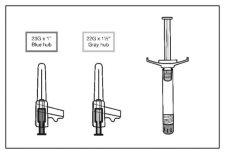
- Встряхніть шприц енергійно протягом щонайменше 10 секунд, щоб забезпечити однорідну суспензію.
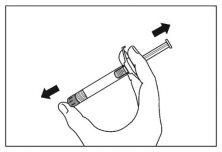
- Виберіть відповідну голку.
Перша доза Паліперидона Стада (150 мг) вводиться в день 1 у м'яз дельтоподібний, використовуючи голку для ін'єкції в дельтоподібний м'яз. Друга доза Паліперидона Стада (100 мг) вводиться також у м'яз дельтоподібний через тиждень (день 8), використовуючи голку для ін'єкції в дельтоподібний м'яз.
Якщо пацієнта переводять з рисперидону ін'єкційного препарату тривалої дії на Паліперидон Стада, перша ін'єкція Паліперидона Стада (діапазон доз 25-150 мг) може бути введена в м'яз дельтоподібний або у м'яз глутеальний, використовуючи відповідну голку для місця ін'єкції, в момент наступної запланованої ін'єкції.
Пізніше ін'єкції підтримання можна вводити як у м'яз дельтоподібний, так і в м'яз глутеальний, використовуючи відповідну голку для місця ін'єкції.
У разі ін'єкції в дельтоподібний м'яз, якщо пацієнт вагою менше 90 кг, використовуйте голку діаметром 23 мм довжиною 1 дюйм (25 мм х 0,6 мм) (голка з осердям синього кольору); якщо пацієнт вагою 90 кг або більше, використовуйте голку діаметром 22 мм довжиною 1,5 дюйма (38 мм х 0,7 мм) (голка з осердям сірого кольору).
У разі ін'єкції в глутеальний м'яз використовуйте голку діаметром 22 мм довжиною 1,5 дюйма (38 мм х 0,7 мм) (голка з осердям сірого кольору).
- Тримаючи шприц у вертикальному положенні, зніміть захисний ковпачок з голки плавним рухом обертання.
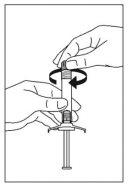
- Відкрийте до половини пакет блістера голки безпеки. Утримуйте кришечку голки, використовуючи пластик пакета. Додайте голку безпеки до з'єднання типу луер шприца плавним рухом обертання за годинниковою стрілкою.
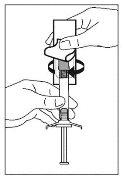
- Відокреміть голку від шприца, рухаючи її вздовж прямої лінії. Не обертайте голку, оскільки вона може відокремитися від шприца.
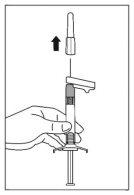
- Помістіть шприц з голкою у вертикальне положення для видалення повітря. Видаліть повітря з шприца, плавно рухаючи плунжер вперед.
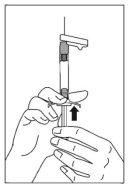
- Введіть увесь вміст шприца повільно, глибоко в м'яз дельтоподібний або глутеальний пацієнта. Не слід вводити внутрішньовенно або підшкірно.
- Після закінчення ін'єкції використовуйте великий палець або інший палець руки (8а, 8б) або пласку поверхню (8в), щоб активувати систему захисту голки. Система повністю активується, коли чути клацання. Витратьте шприц з голкою належним чином.
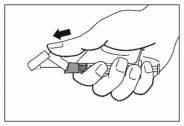
8а
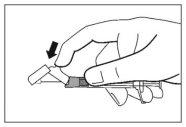
8б
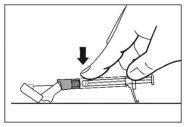
8в
Видалення невикористаного лікарського засобу та всіх матеріалів, що були в контакті з ним, здійснюється згідно з місцевими правилами.

Скільки коштує ПАЛІПЕРИДОН СТАДА 150 мг СУСПЕНЗІЯ ДЛЯ ІН'ЄКЦІЙ ПРОЛОНГОВАНОЇ ДІЇ У ПЕРЕДНАПОЛНЕНИХ ШПРИЦАХ в Іспанії у 2025 році?
ПАЛІПЕРИДОН СТАДА 150 мг СУСПЕНЗІЯ ДЛЯ ІН'ЄКЦІЙ ПРОЛОНГОВАНОЇ ДІЇ У ПЕРЕДНАПОЛНЕНИХ ШПРИЦАХ коштує в середньому 262.27 євро у жовтень, 2025 році. Ціна може змінюватися залежно від регіону, аптеки та наявності рецепта. Рекомендуємо перевіряти актуальну вартість у місцевих аптеках або через онлайн-сервіси.
- Країна реєстрації
- Середня ціна в аптеках262.27 EUR
- Діючі речовини
- Потрібен рецептТак
- Виробник
- СкладPOLISORBATO 20 (12 mg/ml mg), HIDROGENOFOSFATO DE SODIO ANHIDRO (5 mg/ml mg), DIHIDROGENOFOSFATO DE SODIO MONOHIDRATO (2,5 mg/ml mg), HIDROXIDO DE SODIO (E 524) (2,84 mg/ml mg)
- Інформація є довідковою і не є медичною порадою. Перед прийомом будь-яких препаратів обов'язково проконсультуйтеся з лікарем. Oladoctor не несе відповідальності за медичні рішення, прийняті на основі цього контенту.
- Альтернативи до ПАЛІПЕРИДОН СТАДА 150 мг СУСПЕНЗІЯ ДЛЯ ІН'ЄКЦІЙ ПРОЛОНГОВАНОЇ ДІЇ У ПЕРЕДНАПОЛНЕНИХ ШПРИЦАХФорма випуску: РОЗЧИН ДЛЯ ІН'ЄКЦІЙ, 150 мг + 100 мгДіючі речовини: paliperidoneВиробник: Teva Pharma S.L.U.Потрібен рецептФорма випуску: РОЗЧИН ДЛЯ ІН'ЄКЦІЙ, 50 мгДіючі речовини: paliperidoneВиробник: Teva Pharma S.L.U.Потрібен рецептФорма випуску: РОЗЧИН ДЛЯ ІН'ЄКЦІЙ, 1000 мгДіючі речовини: paliperidoneВиробник: Janssen-Cilag International N.VПотрібен рецепт




